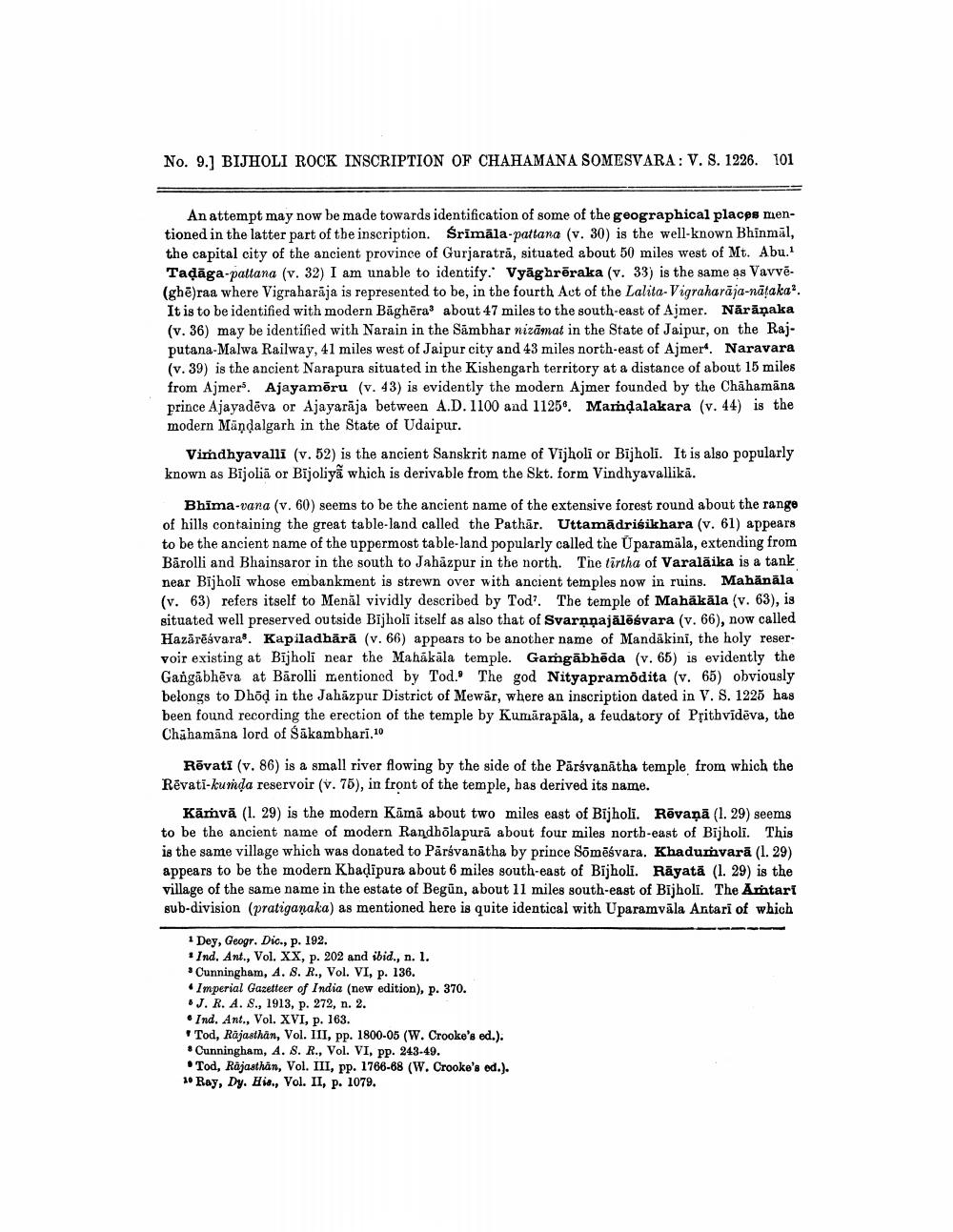________________
No. 9.] BIJHOLI ROCK INSCRIPTION OF CHAHAMANA SOMESVARA: V. S. 1226. 101
An attempt may now be made towards identification of some of the geographical places mentioned in the latter part of the inscription. Srimāla-pattana (v. 30) is the well-known Bhinmāl, the capital city of the ancient province of Gurjaratră, situated about 50 miles west of Mt. Abu.
Tadäga-pattana (v. 32) I am unable to identify. Vyāghrēraka (v. 33) is the same as Vavvē. (ghē)raa where Vigraharāja is represented to be, in the fourth Act of the Lalita-Vigraharāja-nataka?. It is to be identified with modern Baghēra? about 47 miles to the south-east of Ajmer. Nārāņaka (v. 36) may be identified with Narain in the Sambhar nizāmat in the State of Jaipur, on the Rajputana-Malwa Railway, 41 miles west of Jaipur city and 43 miles north-east of Ajmer". Naravara (v. 39) is the ancient Narapura situated in the Kishengarh territory at a distance of about 15 miles from Ajmers. Ajayamēru (v. 43) is evidently the modern Ajmer founded by the Chāhamāna prince Ajayadeva or Ajayarāja between A.D. 1100 and 11256. Mandalakara (v. 44) is the modern Mandalgarh in the State of Udaipur.
Vindhyavalli (v. 52) is the ancient Sanskrit name of Vījholi or Bijholi. It is also popularly known as Bijoliā or Bijoliyã which is derivable from the Skt. form Vindhyavallikā.
Bhima-vana (v. 60) seems to be the ancient name of the extensive forest round about the range of hills containing the great table-land called the Pathār. Uttamādriśikhara (v. 61) appears to be the ancient name of the uppermost table-land popularly called the Ūparamála, extending from Bārolli and Bhainsaror in the south to Jahāzpur in the north. The tirtha of Varalāika is a tank near Bijholi whose embankment is strewn over with ancient temples now in ruins. Mahānāla (v. 63) refers itself to Menál vividly described by Tod? The temple of Mabākāla (v. 63), is situated well preserved outside Bījholi itself as also that of Svarnṇajālēśvara (v. 66), now called Hazārēšvara. Kapiladhārā (v. 66) appears to be another name of Mandakini, the holy reser. voir existing at Bijholi near the Mahākāla temple. Gamgābhāda (v. 65) is evidently the Gangābhēva at Bārolli mentioned by Tod. The god Nityapramodita (v. 65) obviously belongs to Dhōd in the Jahāzpur District of Mewar, where an inscription dated in V. S. 1225 has been found recording the erection of the temple by Kumārapāla, a feudatory of Prithvidēva, the Chāhamāna lord of Sākambhari.10
Rēvati (v. 86) is a small river flowing by the side of the Pārsvanātha temple from which the Rêvati-kunda reservoir (v.75), in front of the temple, bas derived its name.
Kāṁvā (1. 29) is the modern Kämā about two miles east of Bijholi. Rēvaņā (1. 29) seems to be the ancient name of modern Randbõlapurā about four miles north-east of Bijholi. This is the same village which was donated to Parávanātha by prince Somēśvara. Khadunvarā (1.29) appears to be the modern Khadipura about 6 miles south-east of Bijholi. Rāyată (1. 29) is the village of the same name in the estate of Begūn, about 11 miles south-east of Bijholi. The Amtari sub-division (pratiganaka) as mentioned here is quite identical with Uparamvāla Antari of which
1 Dey, Geogr. Dic., p. 192.
Ind. Ant., Vol. XX, p. 202 and ibid., n. 1. * Cunningham, A. S. R., Vol. VI, p. 136. • Imperial Gazetteer of India (new edition), p. 370. 6 J. R. A. 8., 1913, p. 272, n. 2. . Ind. Ant., Vol. XVI, p. 163.
Tod, Rajasthan, Vol. III, pp. 1800-05 (W. Crooke's ed.). * Cunningham, A. S. R., Vol. VI, pp. 243-49.
Tod, Rajasthan, Vol. III, pp. 1766-68 (W. Crooke's ed.). 1. Ray, Dy. Hia., Vol. II, p. 1079.




